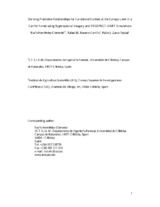Mostrar el registro sencillo del ítem
Deriving predictive relationships of carotenoid content at the canopy level in a conifer forest using hyperspectral imagery and model simulation
| dc.contributor.author | Hernández Clemente, Rocío | |
| dc.contributor.author | Navarro Cerrillo, Rafael M. | |
| dc.contributor.author | Zarco-Tejada, Pablo J. | |
| dc.date.accessioned | 2024-01-31T12:37:45Z | |
| dc.date.available | 2024-01-31T12:37:45Z | |
| dc.date.issued | 2014 | |
| dc.identifier.issn | 1558-0644 | |
| dc.identifier.uri | http://hdl.handle.net/10396/26892 | |
| dc.description.abstract | Recent studies have demonstrated that the R570/R515 index is highly sensitive to carotenoid (Cx + c) content in conifer forest canopies and is scarcely influenced by structural effects. However, validated methods for the prediction of leaf carotenoid content relationships in forest canopies are still needed to date. This paper focuses on the simultaneous retrieval of chlorophyll (Cα + b) and (Cx + c) pigments, which are critical bioindicators of plant physiological status. Radiative transfer theory and modeling assumptions were applied at both laboratory and field scales to develop methods for their concurrent estimation using high-resolution hyperspectral imagery. The proposed methodology was validated based on the biochemical pigment quantification. Canopy modeling methods based on infinite reflectance formulations and the discrete anisotropic radiative transfer (DART) model were evaluated in relation to the PROSPECT-5 leaf model for the scaling-up procedure. Simpler modeling methods yielded comparable results to more complex 3-D approximations due to the high spatial resolution images acquired, which enabled targeting pure crowns and reducing the effects of canopy architecture. The scaling-up methods based on the PROSPECT-5+DART model yielded a root-mean-square error (RMSE) and a relative RMSE of 1.48 μg/cm 2 (17.45%) and 5.03 μg/cm 2 (13.25%) for Cx + c and Cα + b, respectively, while the simpler approach based on the PROSPECT-5+Hapke infinite reflectance model yielded 1.37 μg/cm 2 (17.46%) and 4.71 μg/cm 2 (14.07%) for Cx + c and Cα+b, respectively. These predictive algorithms proved to be useful to estimate Cα + b and Cx + c from high-resolution hyperspectral imagery, providing a methodology for the monitoring of these photosynthetic pigments in conifer forest canopies. | es_ES |
| dc.format.mimetype | application/pdf | es_ES |
| dc.language.iso | eng | es_ES |
| dc.publisher | IEEE | es_ES |
| dc.rights | https://creativecommons.org/licenses/by-nc-nd/4.0/ | es_ES |
| dc.source | R. Hernández-Clemente, R. M. Navarro-Cerrillo and P. J. Zarco-Tejada, "Deriving Predictive Relationships of Carotenoid Content at the Canopy Level in a Conifer Forest Using Hyperspectral Imagery and Model Simulation," in IEEE Transactions on Geoscience and Remote Sensing, vol. 52, no. 8, pp. 5206-5217, Aug. 2014 | es_ES |
| dc.subject | Airborne | es_ES |
| dc.subject | Carotenoids | es_ES |
| dc.subject | Chlorophyll | es_ES |
| dc.subject | Conifers | es_ES |
| dc.subject | Forest | es_ES |
| dc.subject | Hyperspectral | es_ES |
| dc.subject | R515/R570 | es_ES |
| dc.subject | R750/R710 | es_ES |
| dc.subject | Scaling up | es_ES |
| dc.subject | Transformed chlorophyll absorption | es_ES |
| dc.subject | Reflectance index (TCARI) | es_ES |
| dc.subject | Optimized soil-adjusted | es_ES |
| dc.subject | OSAV) | es_ES |
| dc.title | Deriving predictive relationships of carotenoid content at the canopy level in a conifer forest using hyperspectral imagery and model simulation | es_ES |
| dc.type | info:eu-repo/semantics/article | es_ES |
| dc.relation.publisherversion | http://dx.doi.org/10.1109/TGRS.2013.2287304 | es_ES |
| dc.rights.accessRights | info:eu-repo/semantics/openAccess | es_ES |

